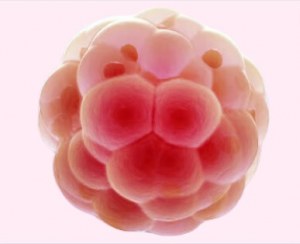
Pluripotent stem cells
Pluripotent stem cells are a type of stem cell with the ability to differentiate into virtually any specialized cell type found in the human body. These cells are capable of developing into cells of all three embryonic germs: ectoderm, mesoderm and endoderm. Pluripotent stem cells are considered a valuable resource in biomedical research and regenerative medicine because of their potential to generate a variety of cell types for studying diseases and developing therapies.
There are two main sources of pluripotent stem cells:
Embryonic stem cells (ESC): Embryonic stem cells are obtained from the embryo at an early stage of development, generally when it consists of around 100 cells called blastocysts. These embryonic stem cells have the capacity to differentiate into all the cell types of the human body.
Induced stem cells (iPS): Induced stem cells are created by genetically reprogramming differentiated adult cells, such as skin cells, to regain a pluripotency similar to that of embryonic stem cells. iPS cells have been a major breakthrough because they avoid the ethical issues associated with the use of embryos.
Biomarkers commonly associated with pluripotent stem cells :
- Oct-4 : It is often used as a basic marker to identify CSPs.
- Nanog : Nanog is another transcriptional protein crucial for pluripotency in embryonic stem cells. It is often co-expressed with Oct-4.
- TRA-1-60 et TRA-1-81 : These antigens are glycoproteins specific to human embryonic stem cells and act as surface markers.
- SSEA-3 et SSEA-4 : These antigens are also surface markers commonly used to identify PSCs.
- Rex-1 : Reduced expression 1 est une protéine associée à la pluripotence et est souvent utilisée comme biomarqueur.
- CD9 et CD90 : These surface markers can be used to identify PSCs.
- Alkaline phosphatase : This enzyme is often used to detect PSCs by staining positive cells blue when activated.
- Nodal/Activin/TGF-β signaling pathway: Activation of this signaling pathway is essential for the maintenance of pluripotency.
Pluripotent stem cells have many important applications in research and medicine:
Studying disease: By differentiating pluripotent stem cells into specific cell types, researchers can create cellular models of disease to study underlying mechanisms, test drugs and develop new therapies. Researchers can target specific genes whose mutation is associated with the disease in question. They can then use genetic modification techniques, such as
- CRISPR-Cas9, to create cell models carrying these mutations. They can also manipulate cell models carrying these mutations. They can also manipulate epigenetic markers to create cellular models of diseases such as methylation and modifications of histones, and the gene expression. Some cell surface antigens can be used to identify and isolate specific cell populations involved in a disease.
- Regenerative medicine : Pluripotent stem cells can be directed to differentiate into the specific cells needed to repair or replace damaged tissues, offering potential for the treatment of degenerative diseases and injuries. Several tools are used to monitor and evaluate the therapeutic potential of stem cells, track their differentiation and measure treatment efficacy: Cell surface markers (CD antigens (Differentiation cluster). For example, human embryonic stem cells express CD133 et SSEA-4, while mesenchymal stem cells express CD44, CD73 et CD90.
- Study of embryonic development: Pluripotent stem cells can be used to study the early stages of the human development, enabling a better understanding of organ and tissue formation processes, using certain biomarkers (Oct4 (Pou5f1); Sox2, SSEA-4 (Stage-Specific Embryonic Antigen-4)).
Pluripotent stem cells are versatile tools that have revolutionized biomedical research and regenerative medicine, offering the possibility of creating disease models, developing innovative therapies and better understanding human development.

